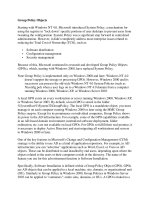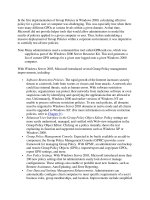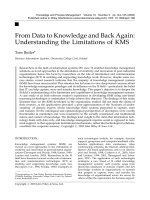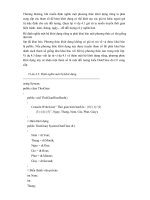Tài liệu Adding restrictions to datatable and datacolumn objects phần 2 pptx
Bạn đang xem bản rút gọn của tài liệu. Xem và tải ngay bản đầy đủ của tài liệu tại đây (33.12 KB, 8 trang )
•
constraintName is the name you want to assign to your constraint.
•
isPrimaryKey indicates whether the constraint is a primary key constraint or just a
regular unique constraint.
The following example uses the Add() method to add a primary key constraint to the
Products DataTable:
myDataSet.Tables["Orders"].Constraints.Add(
"Primary key constraint",
myDataSet.Tables["Orders"].Columns["OrderID"],
true
);
This example does the same thing as the previous example that added the primary key
constraint using the PrimaryKey property. Notice the last parameter to the Add() method
is set to true, which indicates the constraint is for a primary key.
Just as an aside, if you have a column that isn't a primary key but is unique, you can add a
UniqueConstraint object to the ConstraintsCollection. For example:
UniqueConstraint myUC =
new UniqueConstraint(myDataTable.Columns["myColumn"]);
myDataTable.Constraints.Add(myUC);
Adding a Primary Key to the OrderDetails DataTable
Let's consider an example of setting the PrimaryKey property for the Order Details
DataTable. The primary for the Order Details table is made up of the OrderID and
ProductID columns, and the following example sets the PrimaryKey property of the
Order Details DataTable to these two columns:
myDataSet.Tables["Order Details"].PrimaryKey =
new DataColumn[]
{
myDataSet.Tables["Order Details"].Columns["OrderID"],
myDataSet.Tables["Order Details"].Columns["ProductID"]
};
The following example uses the Add() method to do the same thing:
myDataSet.Tables["Order Details"].Constraints.Add(
"Primary key constraint",
new DataColumn[]
{
myDataSet.Tables["Order Details"].Columns["OrderID"],
myDataSet.Tables["Order Details"].Columns["ProductID"]
},
true
);
One thing to keep in mind when adding constraints to a DataTable is that it knows only
about the rows you store in it; it doesn't know about any other rows stored in the actual
database table. To see why this is an issue, consider the following scenario that involves
primary keys:
1. You add a primary key constraint to a DataTable.
2. You retrieve a subset of the rows from a database table and store them in your
DataTable.
3. You add a new DataRow to your DataTable with a primary key value not used in
the subset of rows retrieved into your DataTable in the previous step-but that
primary key value is already used in a row in the database table. Your new
DataRow is added without any problem to the DataTable even though you added a
primary key constraint to your DataTable in step 1. Your new DataRow is added
successfully because the DataTable knows only about the rows stored in it, not the
other rows stored in the database table that were not retrieved in step 2.
4. You attempt to push the new DataRow to the database, but you get a SqlException
that states you've violated the primary key constraint in the database table. This is
because a row in the database table already uses the primary key value.
You need to keep this issue in mind when adding rows to a DataTable, which you'll see
how to do shortly.
That wraps up adding the primary key constraints to the DataTable objects. Next, you'll
see how to add foreign key constraints.
Adding Foreign Key Constraints to the Order Details DataTable
In this section, you'll see how to add a foreign key constraint to the Order Details
DataTable. To do this, you use the Add() method through the Constraints property of the
DataTable.
The following example adds a foreign key constraint from the OrderID DataColumn of
the Order Details DataTable to the OrderID DataColumn of the Orders DataTable:
ForeignKeyConstraint myFKC = new ForeignKeyConstraint(
myDataSet.Tables["Orders"].Columns["OrderID"],
myDataSet.Tables["Order Details"].Columns["OrderID"]
);
myDataSet.Tables["Order Details"].Constraints.Add(myFKC);
Note Notice that the parent DataColumn (OrderID of Orders) is specified before the
child DataColumn (OrderID of Order Details).
The next example adds a foreign key constraint from the ProductID DataColumn of the
Order Details DataTable to the ProductID DataColumn of the Products DataTable:
myDataSet.Tables["Order Details"].Constraints.Add(
"Foreign key constraint to ProductID DataColumn of the " +
"Products DataTable",
myDataSet.Tables["Order Details"].Columns["ProductID"],
myDataSet.Tables["Products"].Columns["ProductID"]
);
That wraps up adding constraints to the DataTable objects. Next, you'll see how to add
restrictions to DataColumn objects.
Adding Restrictions to DataColumn Objects
In this section, you'll see how to add restrictions to the DataColumn objects stored in a
DataTable. Specifically, you'll see how to set the AllowDBNull, AutoIncrement,
AutoIncrementSeed, AutoIncrementStep, ReadOnly, and Unique properties of the
ProductID DataColumn of the Products DataTable. You'll also see how to set the
MaxLength property of the ProductName DataColumn of the Products DataTable.
The ProductID column of the Products database table is an identity column. The seed is
the initial value and the step is the increment added to the last number and they are both
set to 1 for ProductID. The ProductID identity values are therefore 1, 2, 3, and so on.
Tip When you set the AutoIncrementSeed and AutoIncrementStep properties for a
DataColumn that corresponds to a database identity column, you should always set
them both to -1. That way, when you call the Fill() method, ADO.NET will
automatically figure out what values to set the AutoIncrementSeed and
AutoIncrementStep to, based on the values retrieved from the database, and you don't
have to figure out these values yourself.
The following code sets the properties of the ProductID DataColumn:
DataColumn productIDDataColumn =
myDataSet.Tables["Products"].Columns["ProductID"];
productIDDataColumn.AllowDBNull = false;
productIDDataColumn.AutoIncrement = true;
productIDDataColumn.AutoIncrementSeed = -1;
productIDDataColumn.AutoIncrementStep = -1;
productIDDataColumn.ReadOnly = true;
productIDDataColumn.Unique = true;
The next example sets the MaxLength property of the ProductName DataColumn to 40.
This stops you from setting the column value for ProductName to a string greater than 40
characters in length:
myDataSet.Tables["Products"].Columns["ProductName"].MaxLength = 40;
Listing 11.1
uses the code examples shown in this section and the previous one. Notice
this program also displays the ColumnName and DataType properties of the DataColumn
objects in each DataTable. The ColumnName property contains the name of the
DataColumn, and the DataType contains the .NET data type used to represent the column
value stored in the DataColumn.
Listing 11.1: ADDRESTRICTIONS.CS
/*
AddRestrictions.cs illustrates how to add constraints to
DataTable objects and add restrictions to DataColumn objects
*/
using System;
using System.Data;
using System.Data.SqlClient;
class AddRestrictions
{
public static void Main()
{
SqlConnection mySqlConnection =
new SqlConnection(
"server=localhost;database=Northwind;uid=sa;pwd=sa"
);
SqlCommand mySqlCommand = mySqlConnection.CreateCommand();
mySqlCommand.CommandText =
"SELECT ProductID, ProductName " +
"FROM Products;" +
"SELECT OrderID " +
"FROM Orders;" +
"SELECT OrderID, ProductID, UnitPrice " +
"FROM [Order Details];";
SqlDataAdapter mySqlDataAdapter = new SqlDataAdapter();
mySqlDataAdapter.SelectCommand = mySqlCommand;
DataSet myDataSet = new DataSet();
mySqlConnection.Open();
mySqlDataAdapter.Fill(myDataSet);
mySqlConnection.Close();
myDataSet.Tables["Table"].TableName = "Products";
myDataSet.Tables["Table1"].TableName = "Orders";
myDataSet.Tables["Table2"].TableName = "Order Details";
// set the PrimaryKey property for the Products DataTable
// to the ProductID column
DataTable productsDataTable = myDataSet.Tables["Products"];
DataColumn[] productsPrimaryKey =
new DataColumn[]
{
productsDataTable.Columns["ProductID"]
};
productsDataTable.PrimaryKey = productsPrimaryKey;
// set the PrimaryKey property for the Orders DataTable
// to the OrderID column
myDataSet.Tables["Orders"].PrimaryKey =
new DataColumn[]
{
myDataSet.Tables["Orders"].Columns["OrderID"]
};
// set the PrimaryKey property for the Order Details DataTable
// to the OrderID and ProductID columns
myDataSet.Tables["Order Details"].Constraints.Add(
"Primary key constraint on the OrderID and ProductID columns",
new DataColumn[]
{
myDataSet.Tables["Order Details"].Columns["OrderID"],
myDataSet.Tables["Order Details"].Columns["ProductID"]
},
true
);









